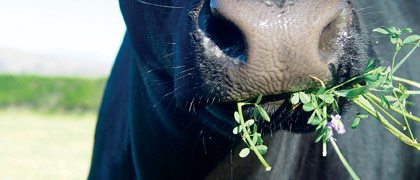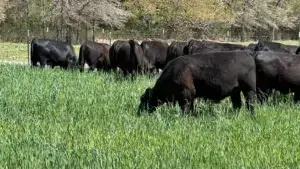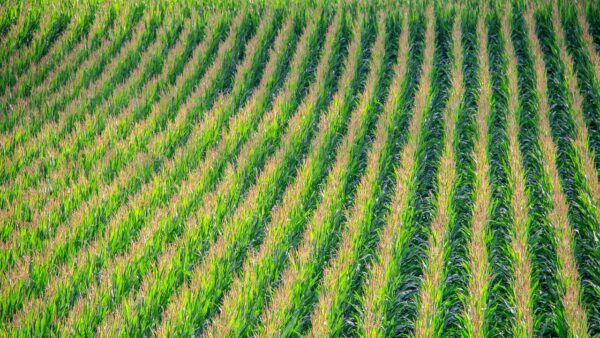Low-Lignin Alfalfa Shows Promise
New GM trait not yet available in Canada, but product might provide significant benefits to producers.
Since April of 2013, after more than a decade of product development, Roundup Ready alfalfa technology has been approved for commercialization in Canada. Within the next couple of years, growers could also benefit from a second genetically modified trait, which is under review, that promises higher-quality alfalfa.
Monsanto and Forage Genetics International have submitted an application for the deregulation of a new GM alfalfa — genetically engineered for reduced lignin content and improved forage quality. The application is currently under review by the U.S. Department of Agriculture, the Canadian Food Inspection Agency (CFIA) and Health Canada.
Although Roundup Ready alfalfa has been approved for commercialization in Canada, it’s not being sold here. If the low-lignin trait is approved by Canadian authorities, Forage Genetics plans to introduce a stacked product that combines the Roundup Ready and low-lignin traits, according to Jose Arias, Forage Genetics director of alfalfa seed production.
Growing or sourcing enough high-quality alfalfa can be a challenge because growers often have to sacrifice quality for quantity.
“We’re excited about reduced lignin, which is the first forage quality trait in GE alfalfa,” says Mark McCaslin, Forage Genetics International vice president of research. “I’ve been talking about it at grower meetings for the past three or four years as we were doing the discovery phase and proof-of-concept. There’s a lot of excitement among growers.”
Lignin is a structural component of alfalfa plants that is indigestible by livestock. The new trait was developed by suppressing a key enzyme during the plant’s synthesis of lignin, resulting in a 12 per cent lower lignin content, according to the deregulation petition before the USDA.
“Rather than putting a new gene in the plant, we took an existing gene and turned down the volume — commonly called a ‘knock out,’” McCaslin explains. “So from a regulatory standpoint, it’s a little different. I wouldn’t say that it will expedite the regulatory process, but it probably simplifies some of the analysis.”
While many are excited, some are hesitant. Surya Acharya is a research scientist with Agriculture and Agri-Food Canada at the Lethbridge Research Centre. He’s very interested in seeing low-lignin alfalfa up close and believes it’s the next breakthrough technology for growers. But Acharya says some challenges might have to be overcome as lignin is a substance that helps alfalfa withstand the elements.
“I would like to see the kind of biomass productivity it has,” Acharya says, noting that in theory, low-lignin levels in alfalfa could lead to weak stems, which means high winds and storms could damage the crop. He also has concerns about its digestibility. “Alfalfa is fairly digestible, and that’s why it can cause bloat,” Acharya says. “With low-lignin alfalfa, I think it would be even more digestible. I’d love to see some of the data. But it sounds like it could definitely help some farmers to delay harvest to a later stage.”
Alfalfa quality isn’t determined completely by the stems. “Quality goes down at a mature stage because the lower leaves, which have almost twice the protein as the stems, drop,” Acharya says. “That’s another consideration I’d love to see data on, how you deal with the leaf aspect if harvest is delayed — what quality impact does that have?”
The developers of the new trait maintain reducing lignin might provide more flexibility for growers, who typically only have a short window for reaping alfalfa before lignin content increases substantially and crop quality declines. According to Monsanto and Forage Genetics International, regular varieties of alfalfa actually contain more lignin than they need, and the new GM alfalfa will contain 12 per cent less lignin, which means the alfalfa will still be able to stand well.
“In producing high-quality alfalfa, there are trade-offs between forage yield and forage quality,” explains Kathleen McAleenan, specialty crops business manager for Monsanto Company. “Alfalfa’s forage quality, digestibility and protein are highest during the early growth stages. After early growth, forage yield will increase, but forage quality decreases. This is because, as the time between cuttings grows longer, or if plants are harvested at later stages, the yield per cutting might increase due to more stems and larger stems.
“On the other hand, overly mature forage is less nutritious because of its higher fibre content. Oftentimes, growers are faced with tough choices between quantity and quality with their alfalfa acres, so there’s inherently a lot of risk in the decisions growers make. Because of this, many growers are interested in the potential benefits that reduced-lignin alfalfa can bring to their operation,” McAleenan adds.
She says the goal of the reduced-lignin effort is to provide farmers with harvest flexibility when adverse weather, equipment failure or competing farm activities arise and to better manage the yield-quality relationship for their alfalfa forage production.
“Oftentimes, growers are faced with tough choices between quantity and quality with their alfalfa acres, so there’s inherently a lot of risk in the decisions growers make.” — Kathleen McAleenan
Producer Benefits
McAleenan says the added yield or quality premium will benefit growers and users of alfalfa. “High-quality alfalfa in dairy cattle rations increases milk production, while controlling feed costs,” she says. “But getting enough high-quality alfalfa is an on-going challenge as growers typically sacrifice yield for quality. Because of the important role alfalfa plays in a dairy operation’s profitability, we believe this particular investment will make a positive difference for growers who seek to produce more high-quality hay.”
Monsanto and Forage Genetics International also teamed up for Roundup Ready alfalfa, genetically engineered to resist glyphosate herbicides.
“We feel good that farmers are finding value in the trait,” McCaslin says. “It’s a unique tool for weed control in alfalfa, especially during establishment, but also for control of perennial weeds in established stands.”
In late 2011, the University of California released the results of a survey that showed 72 per cent of U.S. respondents who grew Roundup Ready alfalfa would grow it again. Forage Genetics has conducted its own market research that echoes those findings. “We’ve done quite a few grower surveys to try to get feedback from growers in terms of their experience with Roundup Ready technology, and what we see generally in all parts of the country is … those growers who are trying it are reporting that they’ve had a positive experience and are planting more acres,” McCaslin says.
McAleenan agrees that Roundup Ready alfalfa continues to be well received by growers, citing a recent grower survey in which 97 per cent of users reported being satisfied with the technology.
“Growers recognize that weed competition in the establishment year reduces alfalfa yield potential and forage quality over the life of the stand,” she says. “These growers know that better stands mean more productivity, longer. We’ve asked early adopters what they like most about the product, and time and again we hear that the technology makes growers’ lives easier and that the added yield pays for the technology in year one of the stand’s life.”
Creating Buzz
McCaslin says the new GM traits being introduced by Forage Genetics International and Monsanto are creating quite a buzz throughout the alfalfa industry, and not just among growers.
“To add value to the seed … is a good thing, for the industry and for agriculture,” he says. “I think the industry is going be supportive of anything that adds value to crops and helps farmers be more profitable. Anything that makes growers happy, the industry is excited about. That’s true for us as a company and the seed industry in general.”
For this reason, the staff at Forage Genetics International are particularly excited about the prospect of combining Roundup Ready technology with the reduced-lignin trait currently in the pipeline.
“We think both of these traits add significant value and flexibility for growers in terms of doing a better job controlling weeds, providing more flexibility in cutting management and increasing the likelihood of producing high-quality hay, for which they get paid a premium,” McCaslin says.
Mark Halsall and Marc Zienkiewicz













